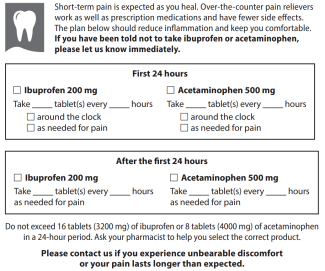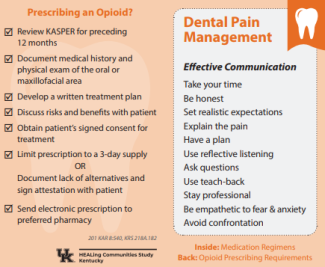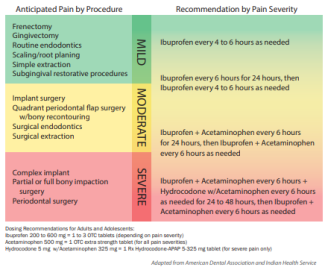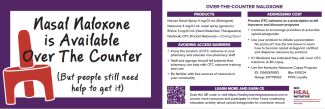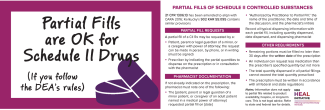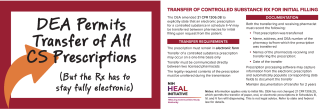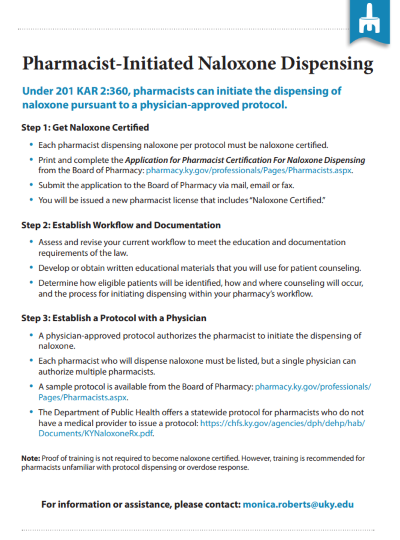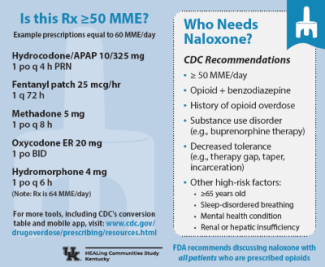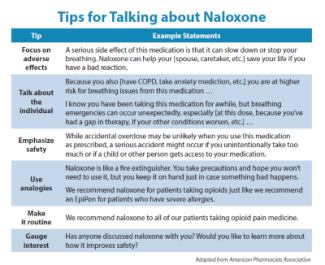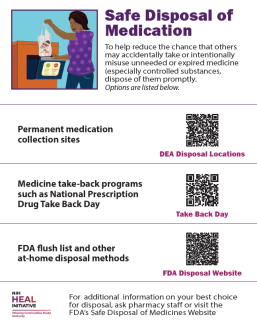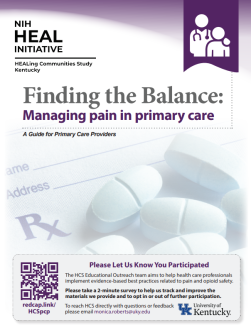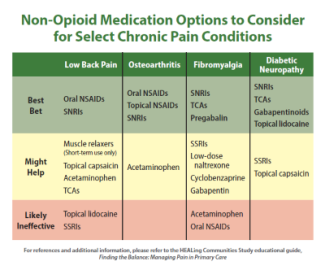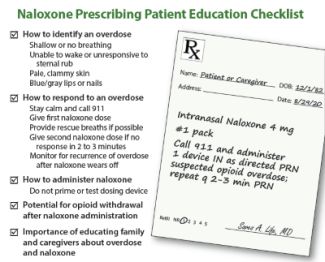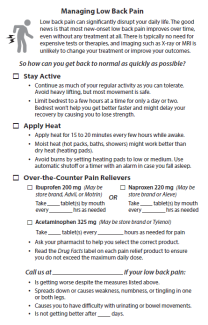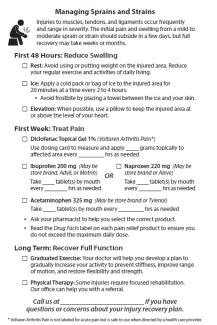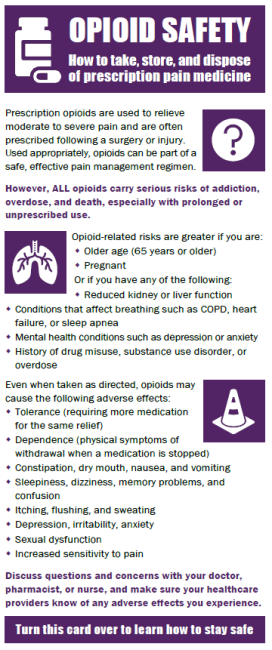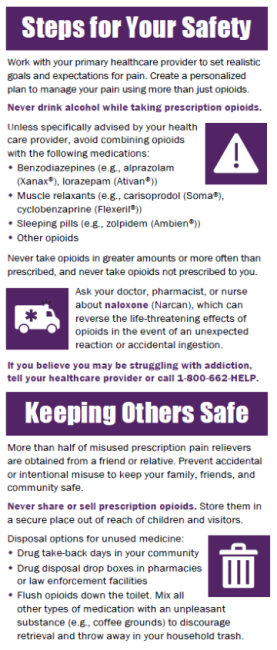The resources below were developed by the Educational Outreach Team of the HEALing Communities Study to support the study's goal of improving opioid prescribing and dispensing practices. The materials are grouped into four categories: Dentist, Pharmacy, Primary Care, and Patients.
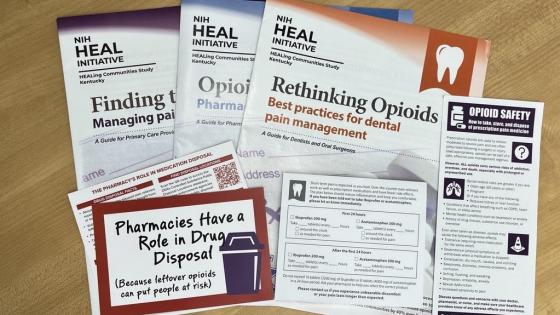
I want to... Access prescription opioid safety educational materials
Healthcare Professional and Patient Education Resources
Dentists
Resources related to best practices for dental pain management, including a handout to use with patients and quick reference tools.
Best practices for dental pain management for dentists and oral surgeons
Dentists and Oral Surgeons looking for information on best practices for dental pain management should download our Rethinking Opioids: Best practices for dental pain management guide. The guide reviews research on the effectiveness of over-the-counter pain relievers, recommendations for acute pain management with NSAIDs and acetaminophen, and safety tips for opioid prescribing.
Managing dental patient pain relief post-procedure
Loosely formatted like a prescription, the Dental Patient Instructions form may be a useful tool for instructing patients to use over-the-counter pain relievers to manage short-term pain following dental procedures.
Quick reference pocket card for dentists
The Dentist Pocket Card lists regulatory requirements when prescribing an opioid, tips for communicating with patients about pain management, and the recommended treatment regimens based on anticipated pain severity. The card was developed to serve as a quick reference tool for dentists.
Pharmacists
Resources designed for pharmacists, pharmacy technicians, pharmacy managers, and/or patients
Guide for opioid safety for pharmacists and pharmacy technicians
The Opioid Safety: Pharmacy at the Forefront guide is designed as a continuing education activity. This guide should empower learners to:
- Discuss key themes of the CDC Clinical Practice Guideline for Prescribing Opioids for Pain with an emphasis on multimodal pain care and opioid tapering
- Recognize high-risk opioid prescriptions
- Review strategies for addressing opioid risks, including safe medication disposal
- Describe why and how pharmacies should dispense naloxone
"Did You Know?" informational cards
Covering multiple topic areas, these "Did You Know?" cards aim to dispel common myths and misconceptions around naloxone availability, safe opioid dispensing practices, and drug disposal.
1. Nasal Naloxone is Available Over The Counter
2. Stopping Chronic Opioid Therapy Has Risks
3. Partial Fills are OK for Schedule II Drugs
4. DEA Permits Transfer of All CS Prescriptions
5. Pharmacies Have a Role in Drug Disposal
Continuing Pharmacy Education (CPE) Courses
Free continuing pharmacy education (CPE) activities and resources remain available through HCS's Prescription Opioid Safety Educational Outreach program. Pharmacists and Pharmacy Technicians may complete and earn ACPE credit for courses, which also meet the Kentucky Board of Pharmacy's continuing education regulatory requirement (as outlined in 201 KAR 2:015).
Featured courses include:
- Improving Medication for Opioid Use Disorder (OUD) in the Pharmacy Setting: An Overview of Treatment Options (2 hour CPE credit)
- Naloxone and Beyond: The Changing Landscape of Opioid Antagonists (1 hour CPE credit)
- Opioid Safety: Pharmacy at the Forefront (1 hour CPE credit)
- Understanding Best Practices for Pain Management: Updates for the Pharmacy Team (2 hour CPE credit)
Naloxone protocol steps
Pharmacists are able to obtain a naloxone certification through the Board of Pharmacy to dispense naloxone. Pharmacies who wish to dispense naloxone should consider establishing a workflow and documentation process before establishing a protocol with a Physician.
Although naloxone is now available over-the-counter, dispensing it as a prescription allows patients to access insurance benefits and discount programs. Pharamacists who wish to initiate naloxone prescriptions should establish a protocol with a Physician. The Pharmacist-Initiated Naloxone Dispensing guide details key steps for starting a per-protocol dispensing program for naloxone.
Naloxone pocket card
Tips for talking to patients about naloxone, CDC recommendations as to who should receive naloxone, as well as examples of prescriptions that meet or exceed the 50 MME threshold for recommending naloxone to patients are outlined on a conveniently sized pocket card. Information on the Naloxone Pocket Card is drawn from the CDC, FDA, and American Pharmacists Association.
KORE KY Naloxone Copay Program
The Kentucky Naloxone Copay Program is administered through a partnership between the Kentucky Opioid Response Effort (KORE) and the Kentucky Pharmacy Education and Research Foundation (KPERF), and allows Kentucky residents to receive naloxone at the pharmacy for free or at a discounted rate. Over-the-Counter Narcan is included in the Copay Program as of September 29, 2023. Read more on the Kentucky Pharmacists Association webpage.
Safe disposal of medication poster
Removing unused medications from the home helps reduce the chance that others may accidentally take or intentionally misuse these medications. KRS 218A.170 requires pharmacists to inform patients about the importance of proper and safe disposal when dispensing certain controlled substances. The Safe Disposal of Medication poster meets this requirement and helps raise patient awareness.
Primary Care Providers (PCP)
Resources designed for primary care providers and healthcare providers across specialties who need to manage patient pain
Guide to managing pain in primary care
Created by the HCS Educational Outreach team, Finding the Balance: Managing pain in primary care is designed to support Primary Care Providers in applying evidence-based best practices related to pain management and opioid safety. The guide outlines best practices designed to help providers:
- Understand and apply the 2022 CDC Guideline for prescribing opioids
- Individualize patient pain management plans
- Use non-opioid therapy as a first line for acute pain
- Treat chronic non-cancer pain with a biopsychosocial approach that maximizes non-opioid therapies
- Consider risk factors for overdose and OUD when prescribing opioids
- Utilize risk mitigation strategies, OUD treatment, and disposal education
- Prescribe naloxone to all patients on long-term opioid therapy
- Collaborate with patients to reduce opioid doses safely and effectively
Non-opioid medication options for pain treatment
Designed for healthcare providers who may be prescribing opioids and/or treating chronic pain, the Opioid Alternatives Pocket Card lists an opioid safety checklist with key considerations, alternative treatment approaches for treating chronic pain, and a matrix that outlines non-opioid medication options by select chronic pain conditions like low back pain or osteoarthritis.
Safely tapering opioids pocket card
Summarizing best practices for opioid tapering and discontinuation, the Opioid Tapering Pocket Card is a useful tool for clinicians caring for patients on chronic opioid therapy for pain.
Naloxone pocket card for primary care providers
The Naloxone Pocket Card for Primary Care includes CDC recommendations for discussing naloxone with patients, examples of prescriptions that meet or exceed the 50 MME threshold for recommending naloxone to patients, and a patient education checklist.
KORE KY Naloxone Copay Program
The Kentucky Naloxone Copay Program is administered through a partnership between the Kentucky Opioid Response Effort (KORE) and the Kentucky Pharmacy Education and Research Foundation (KPERF), and allows Kentucky residents to receive naloxone at the pharmacy for free or at a discounted rate. Over-the-Counter Narcan is included in the Copay Program as of September 29, 2023. Read more on the Kentucky Pharmacists Association webpage.
Managing back pain patient instructions
The Managing Low Back Pain handout can be customized and shared with patients. For patients with new-onset low back pain, staying active, applying heat, and/or over-the-counter pain relievers can effectively manage pain without opioids. Download the Managing Low Back Pain handout today!
Sprains and strains patient instructions
Mild to moderate sprains and strains can be managed effectively following the measures outlined in the Sprains and Strains instructional handout. Healthcare providers may utilize this handout with patients to customize and review treatment within the first 48 hours, the first week, and steps to recover full function in the long term.
Patient Education
Material and information designed to inform patients about opioid safety.
Opioid safety flyer
The Opioid Safety Flyer describes how to take, store, and dispose of prescription pain medication according to evidence-based practices.
The Flyer is also available en español.
Disposal of Medications
Follow the link below to find medication disposal locations in your community.

